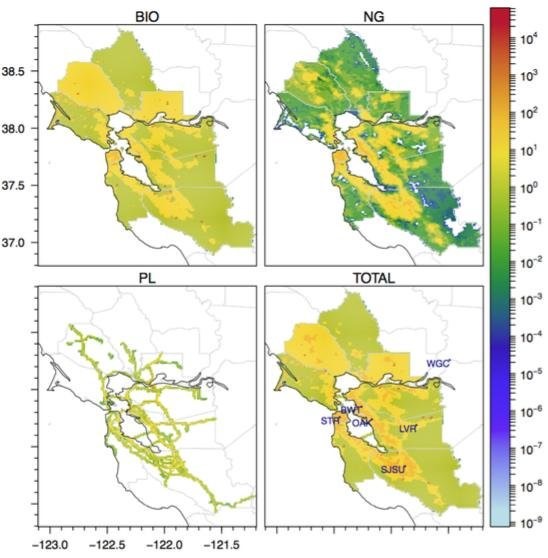
San Francisco Bay Area Methane Emissions May Be Double What We Thought
January 18, 2017 11:58 amSan Francisco Bay Area Methane Emissions May Be Double What We Thought
New study separates biological and natural gas sources of methane
Source: DOE/Lawrence Berkeley National Laboratory
Summary: Emissions of methane, a potent climate-warming gas, in the San Francisco Bay Area may be roughly twice as high as official estimates, with most of it coming from biological sources, such as landfills, but natural gas leakage also being an important source, according to a new study. Emissions of methane — a potent climate-warming gas — may be roughly twice as high as officially estimated for the San Francisco Bay Area.

Most of the emissions come from biological sources, such as landfills, but natural gas leakage is also an important source, according to a new study from the Department of Energy’s Lawrence Berkeley National Laboratory (Berkeley Lab).
The report by researchers Seongeun Jeong and Marc Fischer is the first to quantify the relative contributions of various sources to methane emissions. Their paper, “Estimating methane emissions from biological and fossil-fuel sources in the San Francisco Bay Area,” was recently published online in the journal Geophysical Research Letters. They worked with collaborators at UC Irvine, the National Oceanic and Atmospheric Administration, the Bay Area Air Quality Management District (BAAQMD), Sandia National Laboratories, and San Jose State University.
“This study, along with a few others we’ve published recently, quantifies greenhouse gas emissions from multiple source sectors in a way that will both enable evaluation of AB32 (the California Global Warming Solutions Act) and help guide efforts to mitigate emissions in the future,” Fischer said.
Their study found methane emissions are about 1.8 times what the BAAQMD has estimated. In statistical parlance, their results had a 95 percent confidence level that methane emissions are 1.3 to 2.3 times the inventory. They further found that about 82 percent is from biological sources — most likely from landfills — and 17 percent from fossil fuel sources. Their results were obtained by combining measurements of air samples from six towers in and around the Bay Area with calculations based on atmospheric transport models.
The research was funded by the California Energy Commission’s Natural Gas Research Program. “Quantifying and reducing methane levels is an important tool to California reaching its greenhouse gas reduction goals,” said Robert Weisenmiller, chair of the California Energy Commission.
Methane is a short-lived greenhouse gas that traps about 83 times more heat than carbon dioxide per unit mass when averaged over a 20-year timescale. It stays in the atmosphere for about 10 years, whereas carbon dioxide may stay in the atmosphere for more than 100 years. The primary human-made sources of methane are fossil fuels (natural gas and petroleum), livestock, landfills, and wastewater. There are also natural sources, such as wetlands.
At the statewide scale, the California Air Resources Board (CARB) estimates that the majority of California’s methane emissions occur in the Central Valley. However, the authors note that “increasing evidence suggests that California’s large metropolitan regions constitute another important component of the state’s anthropogenic methane budget … [and] that identifying methane emission sources is important at the sub-regional or city scale for mitigation planning.”
Categorised in: Air pollution, California, Industry news, News, News, Ship & Shore

